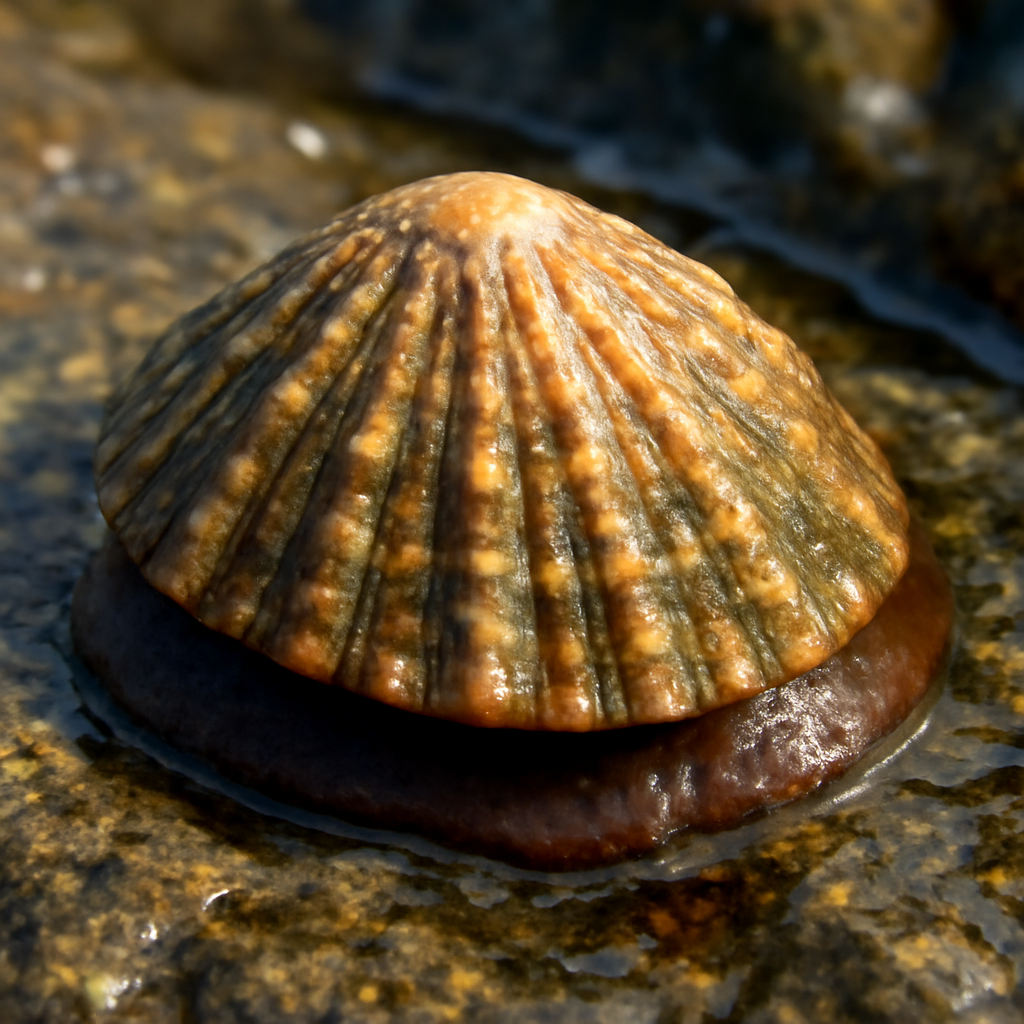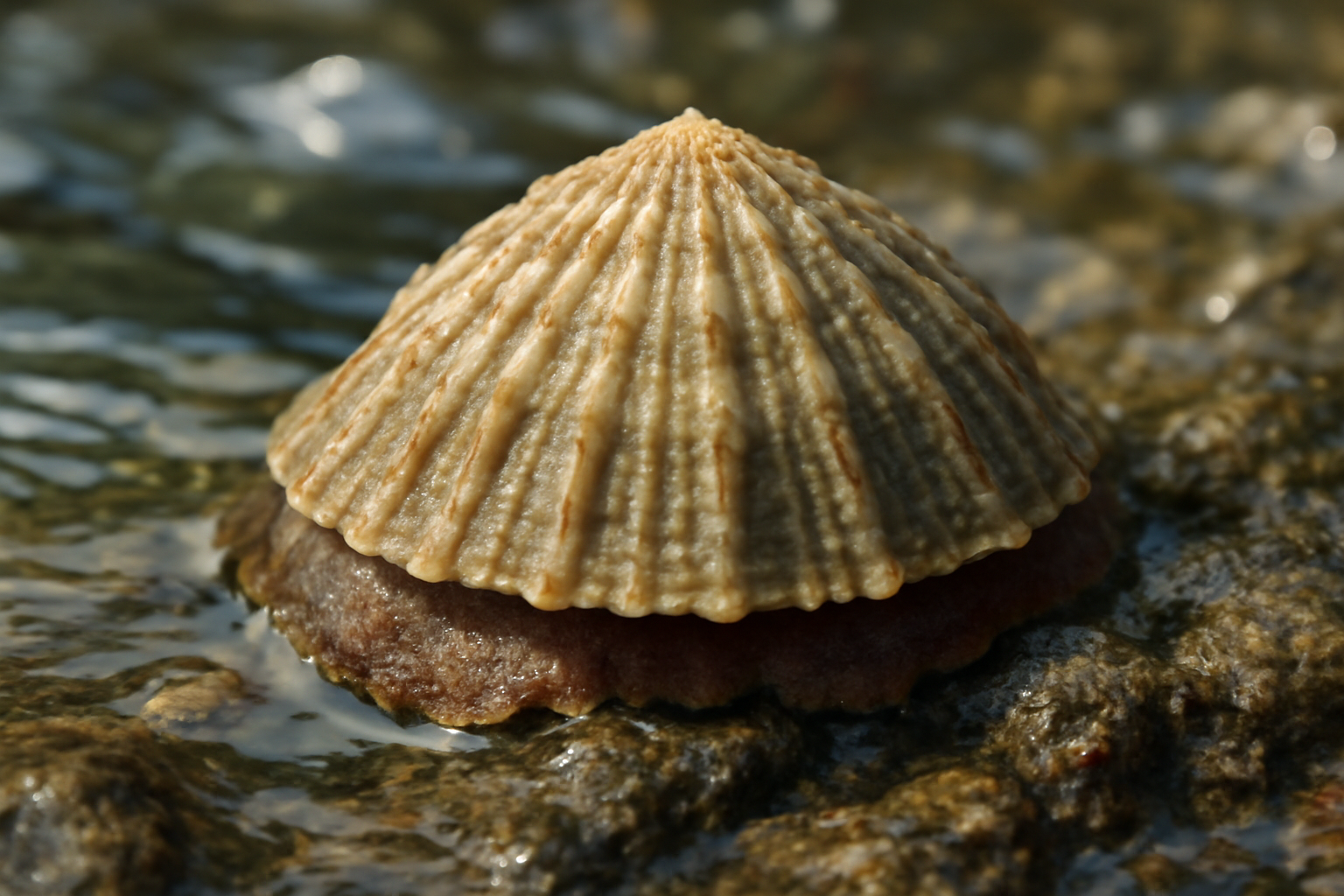Patella: Morphology, Classification, Habitat, and Ecological Role of the True Limpet
Patella is a genus of marine gastropod mollusks commonly known as true limpets. Belonging to the family Patellidae, these animals are characterized by their conical, uncoiled shells and strong adhesion to hard substrates such as rocks in intertidal and subtidal zones. Patella limpets play a vital ecological role as herbivorous grazers, maintaining algal cover balance on rocky shores. Their morphology reflects adaptation to high energy wave-exposed environments, and their physiology is suited for enduring prolonged exposure during low tides.
Classification of Patella
| Taxonomic Rank | Name | Characteristics |
|---|---|---|
| Kingdom | Animalia | Multicellular eukaryotic organisms |
| Phylum | Mollusca | Soft-bodied animals with a muscular foot and mantle |
| Class | Gastropoda | Snails and slugs with a coiled or uncoiled shell |
| Subclass | Patellogastropoda | Limpets with simple, conical shells and docogloss radula |
| Family | Patellidae | True limpets with intertidal distribution and algae grazing habits |
| Genus | Patella | Limpets with single, conical shell and strong substrate adhesion |

Habit and Habitat
Patella species inhabit rocky coastal shores, often exposed to strong wave action and variable environmental conditions including desiccation during low tide. They affix strongly to rocks, boulders, and other hard substrates using their broad, muscular foot. Their conical shells help withstand mechanical stresses from waves and provide protection from predation.
Limpets graze on algae and biofilms growing on rock surfaces using their specialized radula. They trace narrowly defined home ranges and often return to the same spot after foraging, a behavior known as homing. Their activity and grazing pressure play a significant role in structuring intertidal community compositions.
Geographical Distribution
Patella species have a wide distribution throughout the northeastern Atlantic Ocean, Mediterranean Sea, and adjacent coastal regions. Species such as Patella vulgata are commonly found along the British and Irish coasts, Scandinavian shores, and extending along European Atlantic coastlines. Various species occupy distinct microhabitats depending on tidal height, wave exposure, and competition.

General Characteristics
- Commonly called as true limpet.
- Small, oval and sluggish creature.
- Dorsal side of the body is enclosed by a roundish shell, which is raised into a conical elevation by which it is easily recognized.
- Shell forms the miniature volcanic cone and dorsally it contains lines of growth.
- Operculum absent. Underside of the limpet shows a large foot with a broad creeping sole which acts as attachment organ to rocks. Head contains 2 stout, sensory tentacles.
- There are 2 ospbradia, 2 nephridia and a simple heart (1 auricle).
- True mantle cavity is restricted anteriorly and true ctnidia are replaced by pseudotenidia or secondary gills.
- Radula docoglossate with 3 marginals and 3 laterals but no central teeth.
- There is no siphon. A secondary pallial cavity extends all round between the foot and mantle.
- Nervous system shows little concentration towards the head region.
- Shell: Conical, dome-shaped, single-valved with radial ribs or smooth surface, adapted to resist wave action.
- Size: Frequently between 2 and 7 cm in length, though some species grow larger.
- Foot: Large, muscular, used for strong adherence to substrates and locomotion.
- Radula: Docoglossan type with rows of iron-hardened teeth suitable for scraping algae.
- Gills: Located beneath the shell edge on the mantle cavity.
- Coloration: Shell coloration varies by species and habitat, often blending with surroundings.
- Behavior: Movement limited to grazing areas; home scar imprinting during rest for protection.
Special Features
- Adhesion Mechanism: The foot secretes mucus and exerts suction-like forces to cling tightly to irregular surfaces.
- Radula Composition: Teeth reinforced with magnetite enable effective scraping of resistant algal films.
- Shell Strength and Shape: Shape minimizes hydrodynamic force effect, reducing dislodgement during waves.
- Environmental Tolerance: Tolerates desiccation, temperature extremes, and salinity fluctuations typical of intertidal zones.
- Reproductive Timing: Spawning synchronized with environmental cues, such as lunar cycles.
- Ecological Role: Regulates algal growth and contributes to maintaining biodiversity.
Identification
- Shell morphology: shape, size, color, and sculpture.
- Radula structure and tooth arrangement.
- Behavior, such as homing and grazing patterns.
- Molecular studies increasingly used for resolving species complexes.
- Ecological niche and geographic range aid in identification.

Life Cycle and Reproduction
Patella species reproduce sexually, generally with separate sexes. Fertilization is external, releasing eggs and sperm into seawater where fertilization occurs. Larvae hatch as trochophore, then veliger stages before settling on substrate and metamorphosing into juvenile limpets.
Reproduction typically occurs seasonally, often linked with water temperature and daylight length. Juveniles grow gradually, adhering to substrate and feeding similarly to adults. Longevity can vary from 3 to 10 years depending on species and environmental conditions.
Ecological Role and Importance
- Primary Grazers: Control algal and microbial biofilm growth, shaping intertidal community structures.
- Biodiversity Influence: Influence species composition through competition and grazing.
- Prey Species: Food for fish, birds, and invertebrates in coastal ecosystems.
- Environmental Indicator: Sensitive to pollutants and habitat changes; useful for monitoring coastal ecosystem health.
- Economic Use: Consumed by humans traditionally; also used in scientific studies on ecology and physiology.
References
- https://en.wikipedia.org/wiki/Patella_(gastropod)
- https://en.wikipedia.org/wiki/Patellidae
- http://www.marinespecies.org/aphia.php?p=taxdetails&id=140685
- https://www.marlin.ac.uk/species/detail/1371
- https://pmc.ncbi.nlm.nih.gov/articles/PMC11003540/
- https://www.svc.ac.in/SVC_MAIN/Departments/Zoology/Museum/MuseumData/1.%20NON%20CHORDATA/1_10%20MOLLUSCA/10_MOLLUSCA.pdf
- https://www.molluscs.at/gastropoda/sea/limpets.html
- https://uk.inaturalist.org/taxa/130088-Patella
- https://www.ncbi.nlm.nih.gov/Taxonomy/Browser/wwwtax.cgi?id=6465
- https://www.ebsco.com/research-starters/zoology/common-limpet
- https://www.britannica.com/animal/chiton-mollusk
- https://www.vedantu.com/animal/chiton
